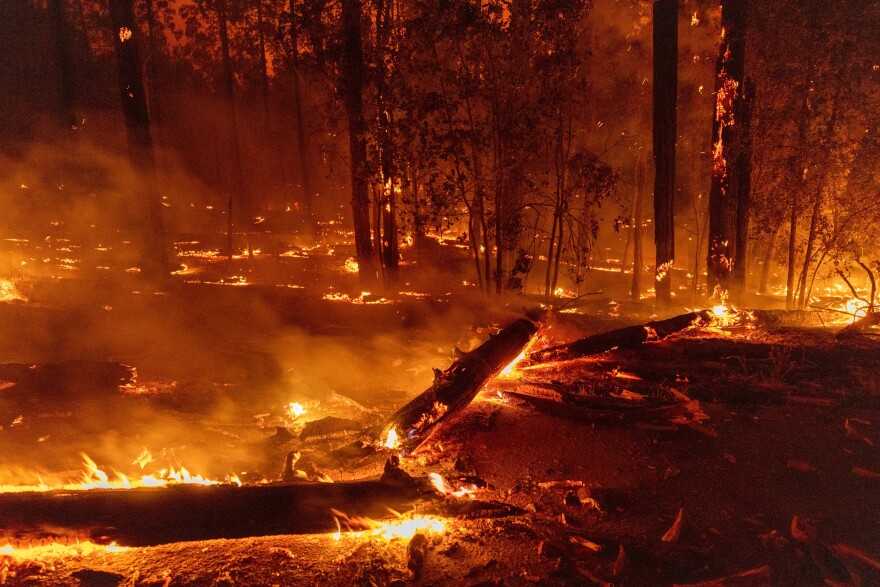The Oak Fire, which burned roughly 20,000 acres west of Yosemite National Park last summer, was devastating to the area's Indigenous tribes — including the Southern Sierra Miwuk Nation. The tribe is headquartered in Mariposa, California, a small town in the Sierra Nevada foothills close to the national park.
"It really hit our community hard," said Tara Fouch-Moore, a member of the Southern Sierra Miwuk's tribal council. "We lost 127 households."
The Oak Fire destroyed much more than property.
"These super fires, they burn so hot," said Jazzmyn Gegere Brochini, the tribe's cultural resource preservation manager. "The Oak Fire disintegrated absolutely everything in its path."
Climate change brought on by the burning of fossil fuels has exacerbated, in part, the frequency and the intensity of wildfires. Such catastrophic fires have decimated culturally significant sites and treasures, raising questions about how to best protect them for the future.
It's something the Southern Sierra Miwuk have had to grapple with.

Gegere Brochini and Fouch-Moore said traditional plants like elderberry, deergrass and sedge used in native cooking, medicine and basket-making were destroyed by the Oak Fire — along with more permanent physical structures, such as the many milling stations carved into the bedrock by ancestors.
The Miwuk people have used these indentations in the rocks to grind traditional medicines and foods like acorns for thousands of years.
"And to think that something that has withstood the test of time for millennia can be destroyed by one fire sweeping through, is a sign that something is changing, and something devastating is happening," said Fouch-Moore.
Cultural heritage and climate change closely intertwined
Indigenous communities have long understood cultural heritage encompasses more than historic buildings and museum artifacts.
"It's also the knowledge of how to find food and how to survive or make art," said Fouch-Moore.
"It's how we coexist with the land and manage it," said Aanthony Lerma, the Southern Sierra Miwuk's stewardship coordinator. "It's the native way of life."
The tribe's firsthand experience of the impact of climate change on cultural traditions has been compounded by displacement.
The Yosemite Valley used to be populated by Indigenous peoples, including the Southern Sierra Miwuk. "In the middle of the 1800s, as Yosemite started to be 'discovered' by settlers, they began to push the Indigenous tribes out," said Cicely Muldoon, the superintendent of Yosemite National Park.

The federal government designated the area as a national park in 1890 to protect its natural treasures. But the cultural ones didn't fare so well: Muldoon said the few remaining Indigenous homes were razed in 1969.
"That was the last permanent occupation by the first people of Yosemite still living in their ancestral homelands," she said.
Loss of place, loss of culture
With the loss of their homelands came the loss of their cultural heritage, such as the long tradition of managing forest fires.
"One of the first things the government outlawed was cultural burning," said the Southern Sierra Miwuk's Lerma.
State officials made this tribal practice of igniting small fires illegal in 1850. The years of fire suppression that followed have made wildfires worse.
"'Smokey the Bear' all over the place," said Fouch-Moore. "And now our forests are overgrown and in bad health. And they're like, 'Oh wait, maybe we should let the Indians do their thing.'"
In recent years, the National Park Service and the California Department of Forestry and Fire Protection (CAL FIRE) have started to collaborate with Indigenous communities to return traditional burning to the land.
Members of local tribes have helped to set prescribed burns in Yosemite National Park, among other wooded areas. The process involves rubbing pieces of wood together to generate sparks instead of using modern drip torches.
"Tribal representatives help us identify and protect important cultural sites during a wildfire," said Gregg Bratcher, deputy chief of CAL FIRE'S prescribed fire program. The agency worked with the Southern Sierra Miwuk and other tribes on the cleanup effort after last year's Oak Fire. "We work with them to ensure these sites are not damaged by fire-fighting or other equipment," he said.
Bratcher said his agency is trying to build trust with tribal communities. Gegere Brochini with the Miwuk Nation said she is glad the state's fire department and other agencies are now actively engaging Indigenous people to clean up after wildfires burn through. She was involved in the cleanup effort after the Oak Fire. "I did a cultural resource spot check to make sure the remains of ancient village sites were protected from the dozers," said Gegere Brochini. "Otherwise they doze everything."
But Tara Fouch-Moore said the removal of Indigenous peoples from their lands makes it hard for traditions like cultural burning to thrive, because out of context, these practices lose their meaning.
"Yes, we can share our songs despite climate change, and yes, we can learn how to process acorn," she said. "But it needs to be whole and within the landscape to really, truly understand."
That's why the Southern Sierra Miwuk Nation has been working for years with the National Park Service to rebuild Wahhoga, a village tribal ancestors once occupied in the Yosemite Valley. "We're building our umachas, which are the bark houses. We are building our roundhouse and we're going to have that area to do our ceremonies and our cultural events," said Fouch-Moore. She expects the project to be completed within the next few years.
Fouch-Moore said Wahhoga will enable her people to tell their own stories.
"That's how you preserve cultural heritage," she said. "By making sure people are still living it."
Copyright 2023 NPR. To see more, visit https://www.npr.org.








